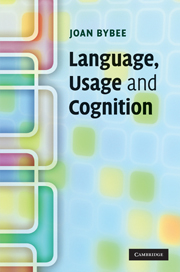Book contents
- Frontmatter
- Contents
- List of figures
- List of tables
- Acknowledgements
- 1 A usage-based perspective on language
- 2 Rich memory for language: exemplar representation
- 3 Chunking and degrees of autonomy
- 4 Analogy and similarity
- 5 Categorization and the distribution of constructions in corpora
- 6 Where do constructions come from? Synchrony and diachrony in a usage-based theory
- 7 Reanalysis or the gradual creation of new categories? The English Auxiliary
- 8 Gradient constituency and gradual reanalysis
- 9 Conventionalization and the local vs. the general: Modern English can
- 10 Exemplars and grammatical meaning: the specific and the general
- 11 Language as a complex adaptive system: the interaction of cognition, culture and use
- Notes
- Bibliography
- Index
10 - Exemplars and grammatical meaning: the specific and the general
Published online by Cambridge University Press: 05 June 2012
- Frontmatter
- Contents
- List of figures
- List of tables
- Acknowledgements
- 1 A usage-based perspective on language
- 2 Rich memory for language: exemplar representation
- 3 Chunking and degrees of autonomy
- 4 Analogy and similarity
- 5 Categorization and the distribution of constructions in corpora
- 6 Where do constructions come from? Synchrony and diachrony in a usage-based theory
- 7 Reanalysis or the gradual creation of new categories? The English Auxiliary
- 8 Gradient constituency and gradual reanalysis
- 9 Conventionalization and the local vs. the general: Modern English can
- 10 Exemplars and grammatical meaning: the specific and the general
- 11 Language as a complex adaptive system: the interaction of cognition, culture and use
- Notes
- Bibliography
- Index
Summary
Introduction
It is important that meaning be specifically addressed in the context of usage-based theory, because as we have seen in many parts of our discussion, morphosyntactic form is very often influenced by meaning. The discussion so far has made reference to meaning a number of times, especially with regard to diachronic change, gradual reanalysis, meaning differences between prefabricated vs. compositional expressions and the meaning of members of categories that fill slots in constructions. Here I want to address directly the matter of grammatical meaning, as usage-based studies of grammaticalization and exemplar models make predictions about the nature of grammatical meaning which have not necessarily been heeded by those who approach meaning from a synchronic structural perspective.
Based on their success in dealing with phonetic and phonological problems, I have applied exemplar modelling to constructions in the previous chapters of this book. In this chapter we will see what the consequences are of analysing grammatical meaning in terms of experienced-based, rich memory representations. I will argue that the semantic categories for grammatical constructions and morphemes are not defined by necessary and sufficient conditions, but rather have the properties that have been discovered for other categories of grammar. Because of their rich category structure and pockets of high- frequency use, it is only natural that grammatical semantic categories (just as lexical ones) could split into two or more categories, creating polysemy in grammatical forms. Exemplar categorization both predicts and models such changes.
Information
- Type
- Chapter
- Information
- Language, Usage and Cognition , pp. 165 - 193Publisher: Cambridge University PressPrint publication year: 2010
